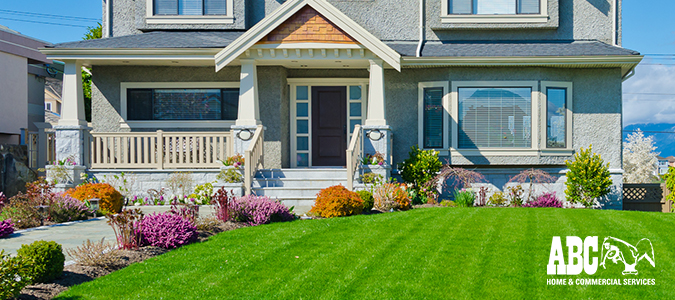Winter weather can leave your landscape wanting. To help bring your landscape back to its fuller and lusher self, it’s important to do some spring lawn prep and maintenance.
Spring lawn care in essential for keeping your yard thriving and resilient through summer. If you want to a beautiful lawn and garden, follow these steps to keep your lawn and landscaping lush and green for the summer.
10 Ways to Get Lawn and Landscaping Ready for Summer
1. Rake It Up
The first step to preparing your yard for spring and summer is to do some raking and cleaning around the home. Use your yard waste container to collect all the leaves, twigs and other debris that has accumulated over winter. Vigorously rake your lawn to clear your landscaping of thatch—dried out, dead grass and organic debris.
The more material you have on the ground, the more difficult it will be for your lawn to get the water and nutrients it needs to thrive.
Make a habit of raking and cleaning up debris every 30 days. By keeping debris to a minimum, your lawn mower will last longer, fertilizer will work better, and the lawn will be safer and healthier.
2. Apply Fertilizer and Pre-Emergent Weed Killer
In early spring, it’s important to apply fertilizer to feed your grass. Also, consider using a pre-emergent herbicide as a natural way to prevent weeds before they grow.
Fertilizer helps supplement the lawn with nutrients it lost during winter. Most experts agree that fertilizer should be applied at least twice a year. Usually, the first fertilization is planned for April or May, however, it all depends on your lawn. Fertilization depends on the type of grass you have, so speak with a professional about the correct lawn care program for you.
Cool-season grasses, such as bluegrass or ryegrass, should be fertilized in early spring and the onset of fall. Warm-season grasses should be fertilized in the spring and again in late summer.
After your spring fertilization, six to eight weeks later, it’s a good idea to reapply both products. Speak with a professional about setting up the perfect fertilization schedule.
Learn more about fertilization and herbicides. When it comes to choosing an organic fertilizer that works, we highly recommend Holganix Bio 800+. Contact the experts at ABC to schedule your fertilization program, weed control, aeration and other lawn services.
3. Consider Adding Mulch
Mulch can cause pest problems if it is too close to the foundation, but otherwise it’s a great way to retain moisture and nutrients during the summer heat.
Mulch can help keep your plants sated and growing, but in some cases it may be a bad idea. Speak with a professional lawn care expert about the proper use of mulch around your home.
4. Mow Right, Mow Often
Don’t let grass grow too high. Try to keep grass height between 2.5 to 3 inches. During peak summer, however, allow the grass to grow about a half inch longer. This helps the grass provide shade and retain moisture.
In addition to providing shelter and harborage for pests, high grasses can also hide rocks, glass, dips, and other potentially hazardous spots. Not only that, when you wait too long to cut the grass, it can stunt the roots.
Try to mow your lawn every five days for the first six weeks of spring. Then, mow about once a week. This will help prevent pests and accidents while ensuring a thicker, lusher lawn. Learn about proper mowing times and techniques.
6. Trim Back Landscaping from Structure
Mulch, grass, and plants that are too close to the foundation can cause major moisture and pest problems. Try to maintain a minimum 2-foot clearance around the entire perimeter of your home. Trim back any trees, bushes or plants that are touching or coming close to the siding.
One other benefit of trimming back plants from your building is getting rid of potential hiding spots for would-be intruders. Many thieves look for large trees and bushes that block the view of their entry through a window or door. Speak to a professional for more landscaping tips to improve home safety and security.
In addition to trimming plants from your siding and foundation, it’s also important to look for any dead or excess growth in other areas of the yard. Pruning promotes healthy plants by eliminating dead or infected parts. It also helps you shape the growth of the tree or bush.
7. Inspect Nearby Trees
Falling trees and branches can cause massive amounts of damage, injury and death. If dead and rotting trees are ignored, they can fall and cause damage and potential injury.
Pay special attention to tree limbs that hang over your home, garage, pathways, stairs and any place where people gather in your yard. If you suspect any kind of tree damage around your property, contact a tree expert (arborist).
To be safe, contact a tree expert every 2-3 years for a professional inspection and safety pruning. This is best done during late winter/early spring before the leaves come out and mask the damage.
8. Consider Aerating Your Lawn
Speak with a professional lawn care expert about core aeration. Most lawns should be aerated every 1-4 years depending on the amount of activity on the lawn. The more foot traffic or heavy objects on a lawn, the more compacted it will get and the more it will need to be aerated.
Aerate your lawn if it shows signs of compaction, such as moss. Moss can also indicate soil acidity (lawns like a neutral pH). If you become aware of soil compaction during your spring lawn checkup, contact a professional for the best plan of action.
9. Keep Pest Prevention in Mind
While conducting your spring and summer landscaping prep, pay attention to any garden pests, such as aphids, grasshoppers, mosquitoes, wasps, termites, springtails, slugs and snails. These creatures may seem innocent enough, but they can destroy your garden and landscaping.
- Choose native, naturally resistant plants around the home.
- Research local pest problems so you can tell the difference between a harmful bug from a welcome one.
- If you have to worry about grazing animals such as rabbits and deer, consider plants that naturally repel these animals.
- Learn how to prevent deer and grazing animals from destroying your garden.
- Learn more spring pest prevention tips.
10. Perform a Soil Test
In addition to problems like compaction and thatch, your soil may also be suffering from a pH imbalance. The best way to know whether your soil has the right pH balance is by hiring a professional to take a soil sample or by sending a soil sample to a local soil testing laboratory.
Learn more about soil tests and pH balances to help solve your lawn problems.
READ THE ULTIMATE GUIDE TO LAWN CARE!
Summer means more foot traffic, a stronger sun, weeds and pests. Prepping and maintaining your yard for summer is not an easy task.
For a beautiful lawn without the work, schedule service with the professional pest management and lawn care professionals at ABC Home & Commercial Services.

